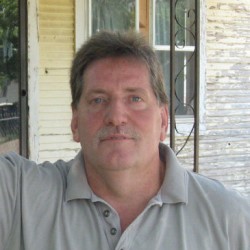 Harold Weatherly (Photo: The Oklahoman)
Moctezuma let the man inside. He made a call while Moctezuma sorted the mail on a desk. Suddenly, the man attacked Moctezuma, stabbing her repeatedly with a knife. She fainted. When she regained consciousness, she tried to call for help. The man reappeared, cut the telephone line, and again repeatedly stabbed her. He then left.
Moctezuma was stabbed approximately 40 times, and she would later testify that she needed to use her hands to keep her organs from falling out of her body. She survived because there was a separate phone line in a back bedroom that she used to to call for help.
Detectives with the Oklahoma City Police Department investigated the brutal attack. With Moctezuma’s help, they created a composite sketch of the man, and used Crime Stoppers to solicit tips from the community.
In early March, they got an anonymous call about Harold Weatherly, who was 25 and lived about six blocks from Moctezuma. The caller said Weatherly resembled the description of the attacker. Separately, Moctezuma’s father had been walking the neighborhood, looking for broken-down trucks, and he had found one outside Weatherly’s house.
Weatherly was questioned, and he was arrested on March 5, 1984 after the results of a polygraph test said he had shown deception in his responses. He was charged with assault with a deadly weapon with intent to kill.
His trial began in Oklahoma on May 14, 1984. Prior to the trial’s start, the prosecution added a second count of assault, asserting that Moctezuma’s injuries were the result of two distinct attacks.
Moctezuma testified that Weatherly was the man who attacked her. While she had picked Weatherly out of a live lineup, she had failed to pick him out of a photo array and also selected another man in a separate array. But now she was sure of her identification.
Bolstering the state’s case was forensic evidence analyzed by Joyce Gilchrist, a forensic chemist in the Oklahoma City Police Department’s crime lab. Police had recovered fibers embedded in mud on a tennis shoe taken from Weatherly’s house, and Gilchrist testified that the fibers had come from Moctezuma’s house, tying him to the crime scene. Her findings were reported to Weatherly’s defense team two days before the trial started. The attorneys moved for a delay to allow time to review this evidence, but Judge Jack Parr denied the request.
Weatherly and Moctezuma did not know each other, and there was no explanation for the assault. Weatherly’s alibi was that he was cleaning out a storage shed with friends and his brother at the time of the attack, but their testimony came under attack because the prosecution established that these witnesses discussed their testimony as a group when meeting with Weatherly’s defense team.
Weatherly testified and said he didn’t attack Moctezuma. He also said the tennis shoe with the fibers was not his; it just looked similar to a pair he owned.
The jury convicted Weatherly of both counts on May 17, 1984. Oklahoma County District Attorney Robert Macy said Weatherly was “possibly the most dangerous man I have ever prosecuted.” He was sentenced on June 15, 1984 to two 20-year prison sentences, to run consecutively.
Weatherly appealed his conviction and sentence. He argued that the second count should not have been added, that Moctezuma’s identification was tainted, and that his attorneys were ineffective for failing to ask the judge to instruct the jury on problems with witness identification. His appeal was rejected by the Oklahoma Court of Criminal Appeals in 1987. A separate appeal said that police failed to turn over a report on a partial set of fingerprints found at the crime scene. By the time of that appeal, in 1997, the fingerprint report had been lost, and the appeal was denied.
Although sentenced to 40 years, Weatherly was released from prison at the end of 1998 and completed his parole in 2002.
In 2001, the Federal Bureau of Investigation conducted a wide-ranging investigation into Gilchrist’s work in the Weatherly case and others where she had provided testimony that shored up the prosecution’s case. The investigation found numerous errors in her methods, results, and conclusions. In September 2001, Gilchrist was fired.
At Weatherly’s trial, Gilchrist had testified: “My opinion is that the person wearing that tennis shoe had to have been associated or had to have been in the home of Moctezuma at 801 S.E. 41st either during the crime or after the crime occurred to have gotten those fibers on the bottom of the shoe.”
But the FBI’s re-examination found that “None of the synthetic fibers associated by Gilchrist actually ‘match’ the fiber samples from the scene.”
After the FBI report, Weatherly applied for a pardon. His first attempt, in 2002, was unsuccessful. He reapplied in 2007, and after the state Pardon and Parole Board recommended approval, Gov. Brad Henry granted Weatherly’s pardon on July 3, 2007.
– Ken Otterbourg
|